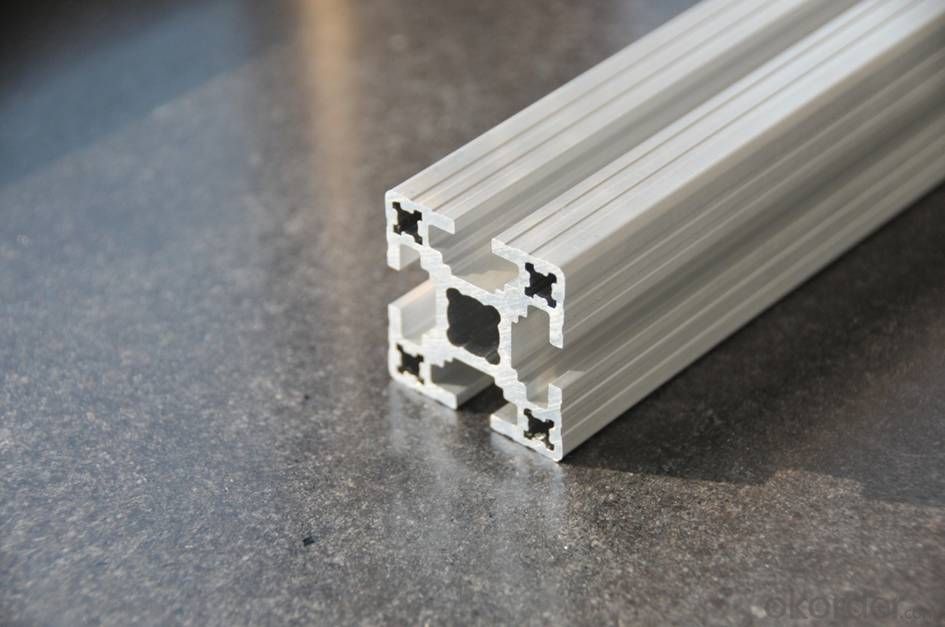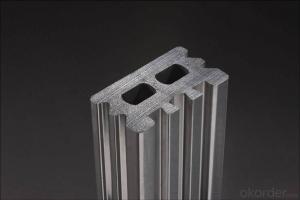Aluminum Extrusion Profiles for TV Parts
- Loading Port:
- Shanghai
- Payment Terms:
- TT OR LC
- Min Order Qty:
- 5 m.t.
- Supply Capability:
- 1000 m.t./month
OKorder Service Pledge
OKorder Financial Service
You Might Also Like
Item specifice
1. Structure of Aluminum Extrusion Profiles for TV Parts Description
Aluminum Extrusion Profiles for TV Parts is one semi-finished aluminium material. It is suitable for belt pulley with all cross sections in mechanical engineering and with good erode-proof and strike-proof performance. Its weight is much lower than steel. So many customers choosed aluminium material instead of steel.
2. Specification of Aluminum Extrusion Profiles for TV Parts
Aluminum Extrusion Profiles for TV Parts | |
Main Specification | |
Alloy | AA1xxx (AA1050, AA1060, AA1070, AA1100 etc.) |
AA3xxx (AA3003, AA3004, AA3005, AA3105 etc.) | |
AA5xxx, AA6XXX (AA5052,AA5083, AA5754, AA6061, AA6062 etc.) | |
AA8xxx(AA8011, AA8006 etc.) | |
Temper | H14,H16, H18, H22, H24, H26, H32,O/F, T4, T6, T651 |
Thickmess | 0.01mm-100mm |
Width | 30mm-1700mm |
Standard | GB/T 3880-2006/ASTM |
Special specification is available on customer's requirement | |
3. Application of Aluminum Extrusion Profiles for TV Parts
(1).Interior: wall cladding, ceilings, bathrooms, kitchens and balconies, shutters, doors...
(2).Exterior: wall cladding, facades, roofing, canopies, tunnels,column covers , renovations...
(3).Advertisement: display platforms, signboards, fascia, shop fronts...
4. Feature of Aluminum Extrusion Profiles for TV Parts
Surfact Quality :
Be free from Oil Stain, Dent, Inclusion, Scratches, Stain, Oxide Dicoloration, Breaks, Corrosion, Roll Marks, Dirt Streaks and other defect which will interfere with use,
Mechenical Property:
Chemical Composite and Mechanical Property
5. Certificate of Aluminum Extrusion Profiles for TV Parts
SGS and ROHS(if client request, paid by client), MTC(plant provided), Certificate of Origin(FORM A, FORM E, CO), Bureau Veritas and SGS (if client request, paid by client), CIQS certificate
6. Image of Aluminum Extrusion Profiles for TV Parts



7. Package and shipping of Aluminum Extrusion Profiles for TV Parts
First, plastic cloth with drying agent inside; Second, Pearl Wool ; Third, wooden cases with dry agent , fumigation wooden pallets, aluminum surface could cover blue PVC film
8. FAQ
1) What is the delivery time?
Depends on actual order, around 20 to 35 days
2) What is the QC system:
We have QC staff of 20 persons and advanced equipment, each production is with MTC traced from Aluminum ingot lot.
3) What market do you mainly sell to?
Australia, America, Asia, Middle East, Western Europe, Africa etc
- Q:What is the typical impact strength of aluminum sheets?
- The typical impact strength of aluminum sheets can vary depending on the alloy and temper of the material. However, in general, aluminum sheets have a relatively low impact strength compared to other metals. This is because aluminum is a lightweight material that is not as strong or durable as steel or other alloys. The impact strength of aluminum sheets is typically measured in terms of the energy required to cause the material to fracture or deform. This can be expressed in units such as joules or foot-pounds. While specific values may vary, aluminum sheets generally have an impact strength ranging from 10 to 40 joules or 7 to 30 foot-pounds. It is important to note that the impact strength can be influenced by factors such as thickness, surface condition, and the presence of any surface treatments or coatings. Therefore, it is recommended to consult the manufacturer's specifications or conduct specific tests to determine the impact strength of a particular aluminum sheet.
- Q:What are the different methods of surface laminating aluminum sheets?
- There exist various techniques for surface laminating aluminum sheets, each with its own distinct advantages and suitability for different purposes. Some of the commonly utilized methods comprise: 1. Adhesive bonding: This involves the application of an adhesive layer between the aluminum sheet and the desired surface material. The adhesive is typically cured through the application of heat or pressure, resulting in a robust bond. This technique is versatile and can be employed with a range of surface materials, including wood, plastic, or glass. 2. Roll bonding: Also referred to as cladding or cold roll bonding, this method entails placing the aluminum sheet between two other metal sheets and subjecting them to high pressure to create a solid bond. Roll bonding is frequently employed in the production of composite materials, such as aluminum-clad steel sheets. 3. Thermal spraying: This process entails melting or heating aluminum powder and using a thermal spray gun to spray it onto the sheet surface. The molten aluminum solidifies upon contact, forming a durable coating. Thermal spraying is commonly used for corrosion protection or as a foundation layer for subsequent surface treatments. 4. Powder coating: In this technique, a dry powder paint is electrostatically applied to the surface of the aluminum sheet. The sheet is then heated, causing the powder to melt and form a smooth and protective coating. Powder coating offers exceptional durability, impact resistance, and a wide array of color options. 5. Anodizing: Anodization is an electrochemical process that enhances the natural oxide layer on the surface of aluminum sheets. By immersing the sheet in an electrolytic bath and applying an electric current, a controlled oxide layer is formed, providing corrosion resistance, improved adhesion for paint or adhesive, and aesthetic finishes. 6. Lamination with protective films: A plastic protective film can be applied to the surface of the aluminum sheet for safeguarding purposes during transportation, handling, or processing. These films offer temporary protection against scratches, abrasions, and dirt. These represent just a few among many techniques available for surface laminating aluminum sheets. The choice of method depends on factors such as desired properties, intended use, and specific application requirements.
- Q:What kind of paint should be sprayed on the aluminium board?
- The aluminum need scraping, the car is not easy to enamel paint.Is the aluminum plate with a thickness of more than 0.2mm to 500mm, 200mm width, length less than 16m aluminum material called aluminum plate or aluminum sheet, aluminum is below 0.2mm, 200mm within the width of the row material or bar (of course, with the progress of the large equipment, the width can be 600mm row material also more).
- Q:Are aluminum sheets suitable for artistic sculptures?
- Yes, aluminum sheets are suitable for artistic sculptures. Aluminum is a versatile material that can be easily shaped, manipulated, and welded. It is lightweight, durable, and resistant to corrosion, making it ideal for creating intricate and long-lasting sculptures. Additionally, aluminum's natural silver color can add a contemporary and modern aesthetic to the artwork.
- Q:Can aluminum sheets be coated with other materials?
- Yes, aluminum sheets can be coated with other materials. Aluminum is a versatile metal that can be easily coated with various substances, such as paints, lacquers, polymers, and specialty coatings. These coatings can enhance the appearance, durability, corrosion resistance, and thermal or electrical properties of the aluminum sheets.
- Q:What does exterior wall imitate aluminium paint have? Imitate aluminium plate paint is fluorocarbon paint?
- The exterior walls are painted with aluminium and plastic panels, and only fluorocarbon metal paint is used. The fluorine content determines the service life;The construction technology of fluorocarbon metal paint is relatively complex, and the price is more expensive, generally including the construction is roughly equivalent to more than half the price point to use aluminum plate;
- Q:Are aluminum sheets suitable for chemical processing applications?
- Yes, aluminum sheets are suitable for chemical processing applications. Aluminum is known for its excellent corrosion resistance, making it a popular choice in various chemical industries. It can withstand exposure to many chemicals, including acids, alkalis, and organic solvents. Additionally, aluminum sheets are lightweight, easy to work with, and offer good thermal conductivity, making them versatile and efficient for chemical processing applications.
- Q:Is aluminum sheet corrosion-resistant?
- Yes, aluminum sheet is corrosion-resistant. Aluminum forms a protective oxide layer on its surface when exposed to oxygen in the air, which helps prevent further corrosion. This oxide layer acts as a barrier, protecting the underlying metal from moisture, chemicals, and other corrosive elements. Additionally, aluminum has a high resistance to corrosion caused by saltwater, making it a popular choice for marine applications. However, it is important to note that certain conditions, such as exposure to acidic or alkaline environments, can still cause corrosion on aluminum surfaces if not properly maintained or protected.
- Q:what's the difference between the knocking voice of aluminum sheet and stainless steel?
- The voice of aluminum sheet is toneless, and the voice of stanless steel is more crisp.
- Q:How does aluminum sheet perform in high-pressure applications?
- Aluminum sheet performs well in high-pressure applications due to its high strength-to-weight ratio and excellent corrosion resistance. It can withstand elevated pressures without deforming or rupturing, making it a reliable choice for various industries such as aerospace, automotive, and marine.
1. Manufacturer Overview |
|
|---|---|
| Location | |
| Year Established | |
| Annual Output Value | |
| Main Markets | |
| Company Certifications | |
2. Manufacturer Certificates |
|
|---|---|
| a) Certification Name | |
| Range | |
| Reference | |
| Validity Period | |
3. Manufacturer Capability |
|
|---|---|
| a)Trade Capacity | |
| Nearest Port | |
| Export Percentage | |
| No.of Employees in Trade Department | |
| Language Spoken: | |
| b)Factory Information | |
| Factory Size: | |
| No. of Production Lines | |
| Contract Manufacturing | |
| Product Price Range | |
Send your message to us
Aluminum Extrusion Profiles for TV Parts
- Loading Port:
- Shanghai
- Payment Terms:
- TT OR LC
- Min Order Qty:
- 5 m.t.
- Supply Capability:
- 1000 m.t./month
OKorder Service Pledge
OKorder Financial Service
Similar products
New products
Hot products
Related keywords




























